Comparative Report: Energy and Water Sustainability in Australia & UAE
VerifiedAdded on 2020/04/07
|10
|2193
|47
Report
AI Summary
This report provides a comparative analysis of energy and water sustainability in Australia and the United Arab Emirates (UAE). It examines the energy landscape in Australia, including government regulations promoting renewable energy and technological innovations like solar and biomass, as well as actions by non-governmental and private sectors. The report then explores energy sustainability efforts in the UAE, including government strategies and regulations. Similarly, it delves into water sustainability in both countries, outlining government regulations, projects, and technologies implemented for water conservation and management. The comparison highlights the different approaches taken by each country, focusing on their effectiveness in addressing energy and water scarcity challenges, and concludes with a discussion of sustainable development goals and strategies.
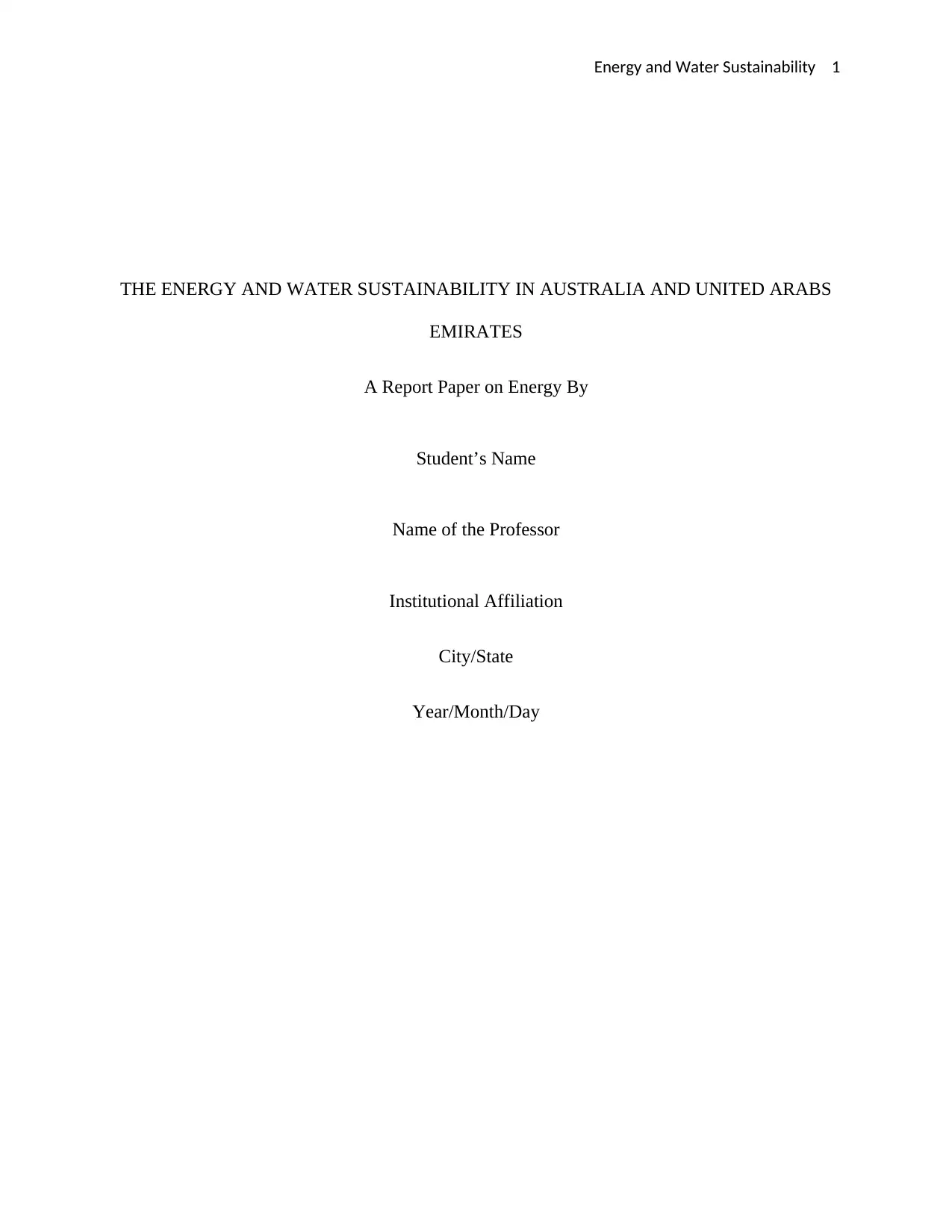
Energy and Water Sustainability 1
THE ENERGY AND WATER SUSTAINABILITY IN AUSTRALIA AND UNITED ARABS
EMIRATES
A Report Paper on Energy By
Student’s Name
Name of the Professor
Institutional Affiliation
City/State
Year/Month/Day
THE ENERGY AND WATER SUSTAINABILITY IN AUSTRALIA AND UNITED ARABS
EMIRATES
A Report Paper on Energy By
Student’s Name
Name of the Professor
Institutional Affiliation
City/State
Year/Month/Day
Paraphrase This Document
Need a fresh take? Get an instant paraphrase of this document with our AI Paraphraser
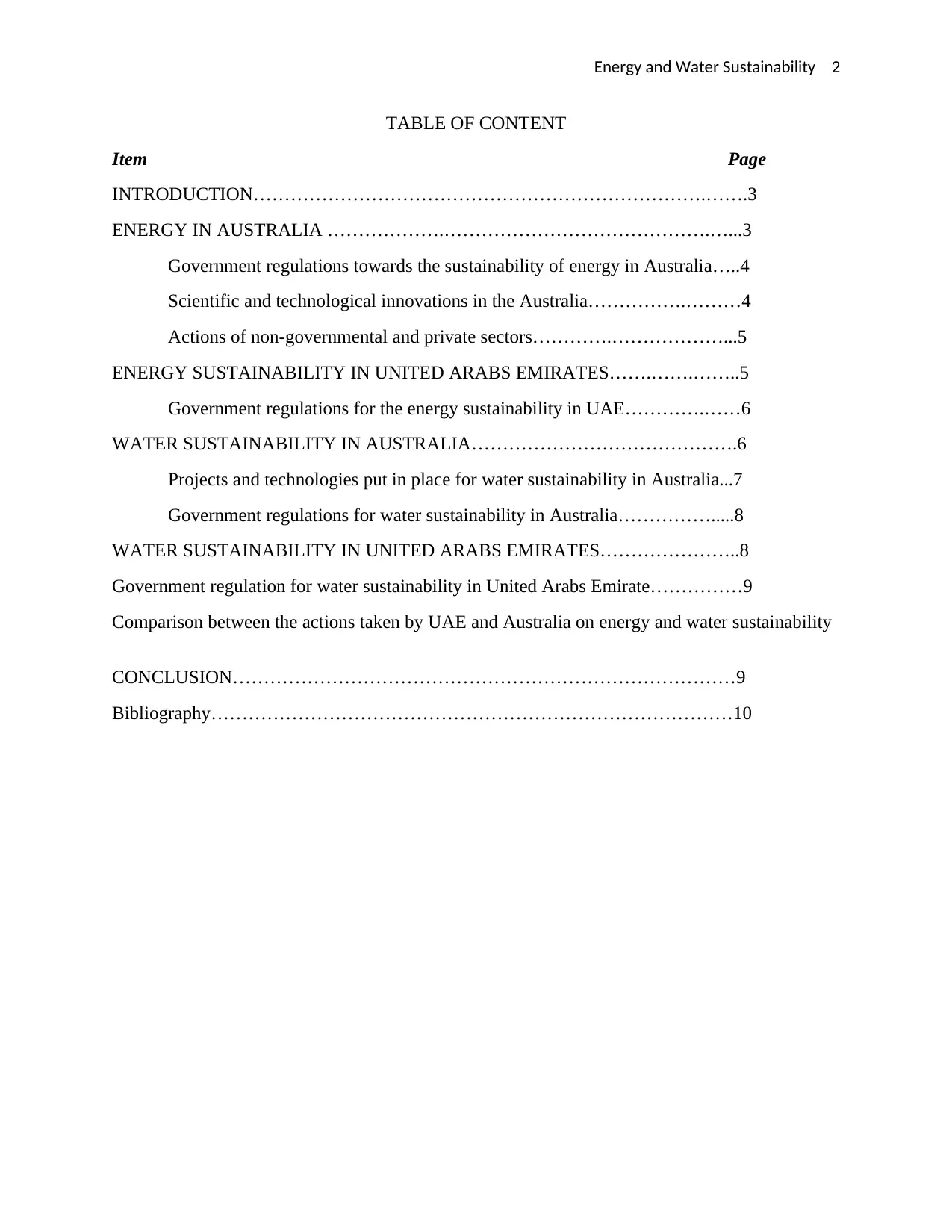
Energy and Water Sustainability 2
TABLE OF CONTENT
Item Page
INTRODUCTION……………………………………………………………….…….3
ENERGY IN AUSTRALIA ……………….…………………………………….…...3
Government regulations towards the sustainability of energy in Australia…..4
Scientific and technological innovations in the Australia…………….………4
Actions of non-governmental and private sectors………….………………...5
ENERGY SUSTAINABILITY IN UNITED ARABS EMIRATES…….…….……..5
Government regulations for the energy sustainability in UAE………….……6
WATER SUSTAINABILITY IN AUSTRALIA…………………………………….6
Projects and technologies put in place for water sustainability in Australia...7
Government regulations for water sustainability in Australia…………….....8
WATER SUSTAINABILITY IN UNITED ARABS EMIRATES…………………..8
Government regulation for water sustainability in United Arabs Emirate……………9
Comparison between the actions taken by UAE and Australia on energy and water sustainability
CONCLUSION………………………………………………………………………9
Bibliography…………………………………………………………………………10
TABLE OF CONTENT
Item Page
INTRODUCTION……………………………………………………………….…….3
ENERGY IN AUSTRALIA ……………….…………………………………….…...3
Government regulations towards the sustainability of energy in Australia…..4
Scientific and technological innovations in the Australia…………….………4
Actions of non-governmental and private sectors………….………………...5
ENERGY SUSTAINABILITY IN UNITED ARABS EMIRATES…….…….……..5
Government regulations for the energy sustainability in UAE………….……6
WATER SUSTAINABILITY IN AUSTRALIA…………………………………….6
Projects and technologies put in place for water sustainability in Australia...7
Government regulations for water sustainability in Australia…………….....8
WATER SUSTAINABILITY IN UNITED ARABS EMIRATES…………………..8
Government regulation for water sustainability in United Arabs Emirate……………9
Comparison between the actions taken by UAE and Australia on energy and water sustainability
CONCLUSION………………………………………………………………………9
Bibliography…………………………………………………………………………10
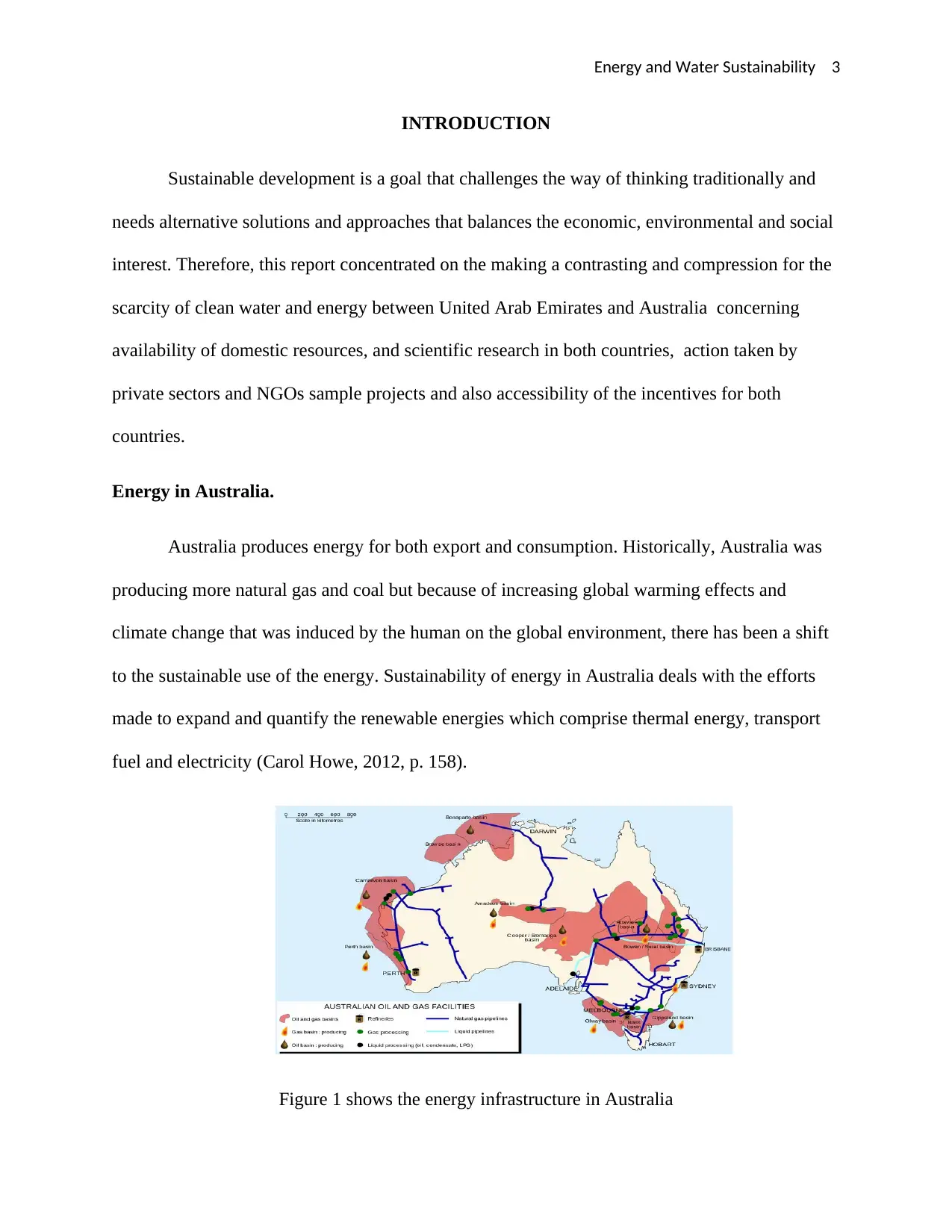
Energy and Water Sustainability 3
INTRODUCTION
Sustainable development is a goal that challenges the way of thinking traditionally and
needs alternative solutions and approaches that balances the economic, environmental and social
interest. Therefore, this report concentrated on the making a contrasting and compression for the
scarcity of clean water and energy between United Arab Emirates and Australia concerning
availability of domestic resources, and scientific research in both countries, action taken by
private sectors and NGOs sample projects and also accessibility of the incentives for both
countries.
Energy in Australia.
Australia produces energy for both export and consumption. Historically, Australia was
producing more natural gas and coal but because of increasing global warming effects and
climate change that was induced by the human on the global environment, there has been a shift
to the sustainable use of the energy. Sustainability of energy in Australia deals with the efforts
made to expand and quantify the renewable energies which comprise thermal energy, transport
fuel and electricity (Carol Howe, 2012, p. 158).
Figure 1 shows the energy infrastructure in Australia
INTRODUCTION
Sustainable development is a goal that challenges the way of thinking traditionally and
needs alternative solutions and approaches that balances the economic, environmental and social
interest. Therefore, this report concentrated on the making a contrasting and compression for the
scarcity of clean water and energy between United Arab Emirates and Australia concerning
availability of domestic resources, and scientific research in both countries, action taken by
private sectors and NGOs sample projects and also accessibility of the incentives for both
countries.
Energy in Australia.
Australia produces energy for both export and consumption. Historically, Australia was
producing more natural gas and coal but because of increasing global warming effects and
climate change that was induced by the human on the global environment, there has been a shift
to the sustainable use of the energy. Sustainability of energy in Australia deals with the efforts
made to expand and quantify the renewable energies which comprise thermal energy, transport
fuel and electricity (Carol Howe, 2012, p. 158).
Figure 1 shows the energy infrastructure in Australia
⊘ This is a preview!⊘
Do you want full access?
Subscribe today to unlock all pages.

Trusted by 1+ million students worldwide
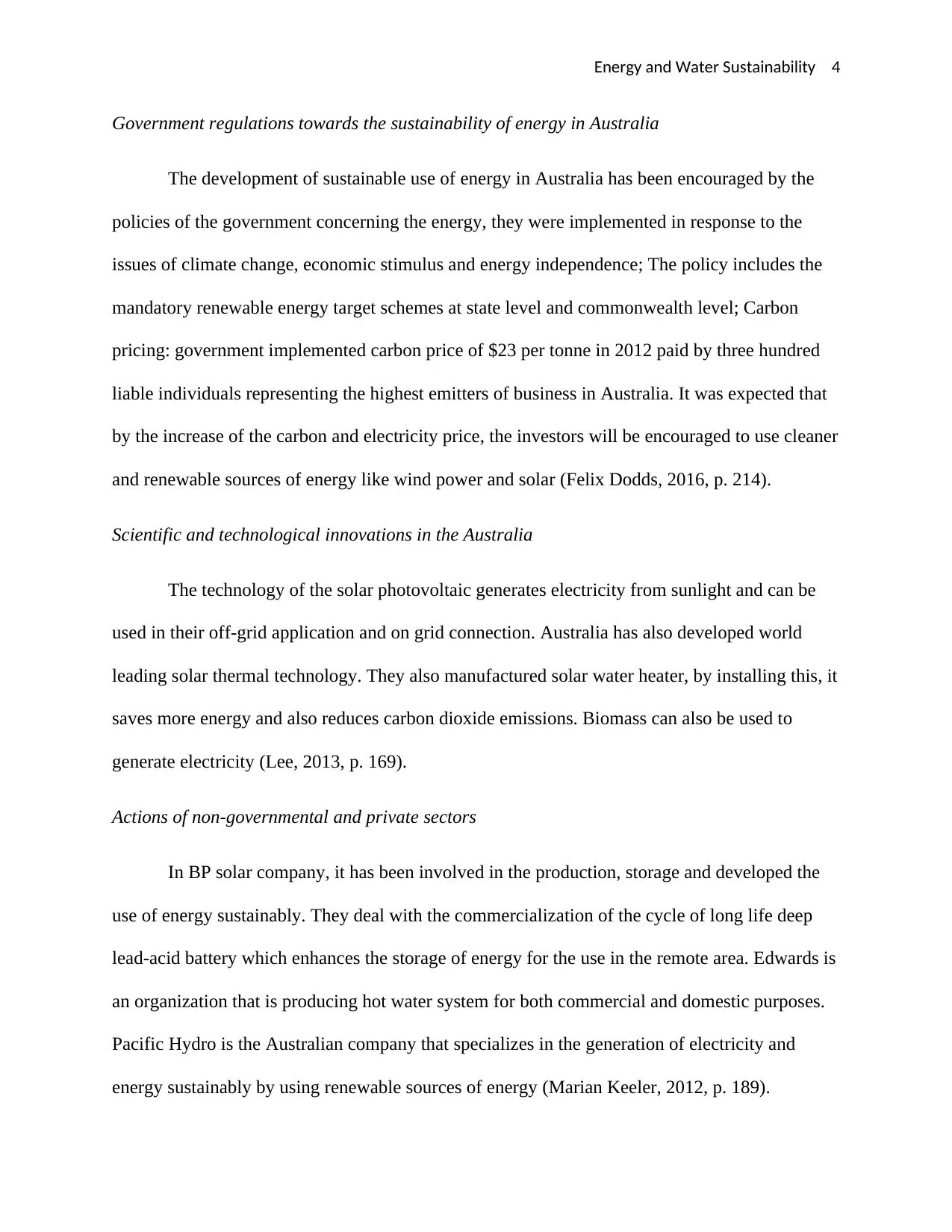
Energy and Water Sustainability 4
Government regulations towards the sustainability of energy in Australia
The development of sustainable use of energy in Australia has been encouraged by the
policies of the government concerning the energy, they were implemented in response to the
issues of climate change, economic stimulus and energy independence; The policy includes the
mandatory renewable energy target schemes at state level and commonwealth level; Carbon
pricing: government implemented carbon price of $23 per tonne in 2012 paid by three hundred
liable individuals representing the highest emitters of business in Australia. It was expected that
by the increase of the carbon and electricity price, the investors will be encouraged to use cleaner
and renewable sources of energy like wind power and solar (Felix Dodds, 2016, p. 214).
Scientific and technological innovations in the Australia
The technology of the solar photovoltaic generates electricity from sunlight and can be
used in their off-grid application and on grid connection. Australia has also developed world
leading solar thermal technology. They also manufactured solar water heater, by installing this, it
saves more energy and also reduces carbon dioxide emissions. Biomass can also be used to
generate electricity (Lee, 2013, p. 169).
Actions of non-governmental and private sectors
In BP solar company, it has been involved in the production, storage and developed the
use of energy sustainably. They deal with the commercialization of the cycle of long life deep
lead-acid battery which enhances the storage of energy for the use in the remote area. Edwards is
an organization that is producing hot water system for both commercial and domestic purposes.
Pacific Hydro is the Australian company that specializes in the generation of electricity and
energy sustainably by using renewable sources of energy (Marian Keeler, 2012, p. 189).
Government regulations towards the sustainability of energy in Australia
The development of sustainable use of energy in Australia has been encouraged by the
policies of the government concerning the energy, they were implemented in response to the
issues of climate change, economic stimulus and energy independence; The policy includes the
mandatory renewable energy target schemes at state level and commonwealth level; Carbon
pricing: government implemented carbon price of $23 per tonne in 2012 paid by three hundred
liable individuals representing the highest emitters of business in Australia. It was expected that
by the increase of the carbon and electricity price, the investors will be encouraged to use cleaner
and renewable sources of energy like wind power and solar (Felix Dodds, 2016, p. 214).
Scientific and technological innovations in the Australia
The technology of the solar photovoltaic generates electricity from sunlight and can be
used in their off-grid application and on grid connection. Australia has also developed world
leading solar thermal technology. They also manufactured solar water heater, by installing this, it
saves more energy and also reduces carbon dioxide emissions. Biomass can also be used to
generate electricity (Lee, 2013, p. 169).
Actions of non-governmental and private sectors
In BP solar company, it has been involved in the production, storage and developed the
use of energy sustainably. They deal with the commercialization of the cycle of long life deep
lead-acid battery which enhances the storage of energy for the use in the remote area. Edwards is
an organization that is producing hot water system for both commercial and domestic purposes.
Pacific Hydro is the Australian company that specializes in the generation of electricity and
energy sustainably by using renewable sources of energy (Marian Keeler, 2012, p. 189).
Paraphrase This Document
Need a fresh take? Get an instant paraphrase of this document with our AI Paraphraser
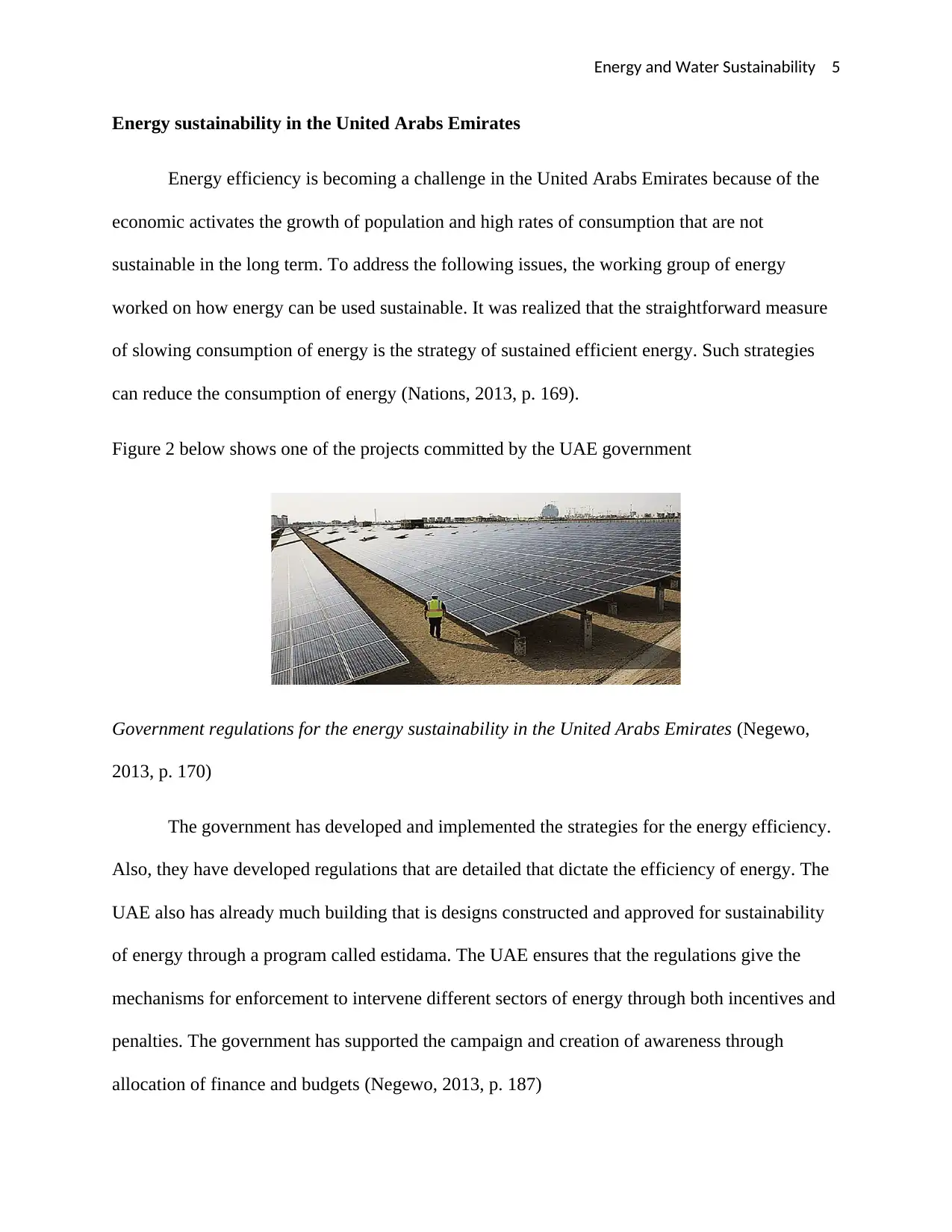
Energy and Water Sustainability 5
Energy sustainability in the United Arabs Emirates
Energy efficiency is becoming a challenge in the United Arabs Emirates because of the
economic activates the growth of population and high rates of consumption that are not
sustainable in the long term. To address the following issues, the working group of energy
worked on how energy can be used sustainable. It was realized that the straightforward measure
of slowing consumption of energy is the strategy of sustained efficient energy. Such strategies
can reduce the consumption of energy (Nations, 2013, p. 169).
Figure 2 below shows one of the projects committed by the UAE government
Government regulations for the energy sustainability in the United Arabs Emirates (Negewo,
2013, p. 170)
The government has developed and implemented the strategies for the energy efficiency.
Also, they have developed regulations that are detailed that dictate the efficiency of energy. The
UAE also has already much building that is designs constructed and approved for sustainability
of energy through a program called estidama. The UAE ensures that the regulations give the
mechanisms for enforcement to intervene different sectors of energy through both incentives and
penalties. The government has supported the campaign and creation of awareness through
allocation of finance and budgets (Negewo, 2013, p. 187)
Energy sustainability in the United Arabs Emirates
Energy efficiency is becoming a challenge in the United Arabs Emirates because of the
economic activates the growth of population and high rates of consumption that are not
sustainable in the long term. To address the following issues, the working group of energy
worked on how energy can be used sustainable. It was realized that the straightforward measure
of slowing consumption of energy is the strategy of sustained efficient energy. Such strategies
can reduce the consumption of energy (Nations, 2013, p. 169).
Figure 2 below shows one of the projects committed by the UAE government
Government regulations for the energy sustainability in the United Arabs Emirates (Negewo,
2013, p. 170)
The government has developed and implemented the strategies for the energy efficiency.
Also, they have developed regulations that are detailed that dictate the efficiency of energy. The
UAE also has already much building that is designs constructed and approved for sustainability
of energy through a program called estidama. The UAE ensures that the regulations give the
mechanisms for enforcement to intervene different sectors of energy through both incentives and
penalties. The government has supported the campaign and creation of awareness through
allocation of finance and budgets (Negewo, 2013, p. 187)
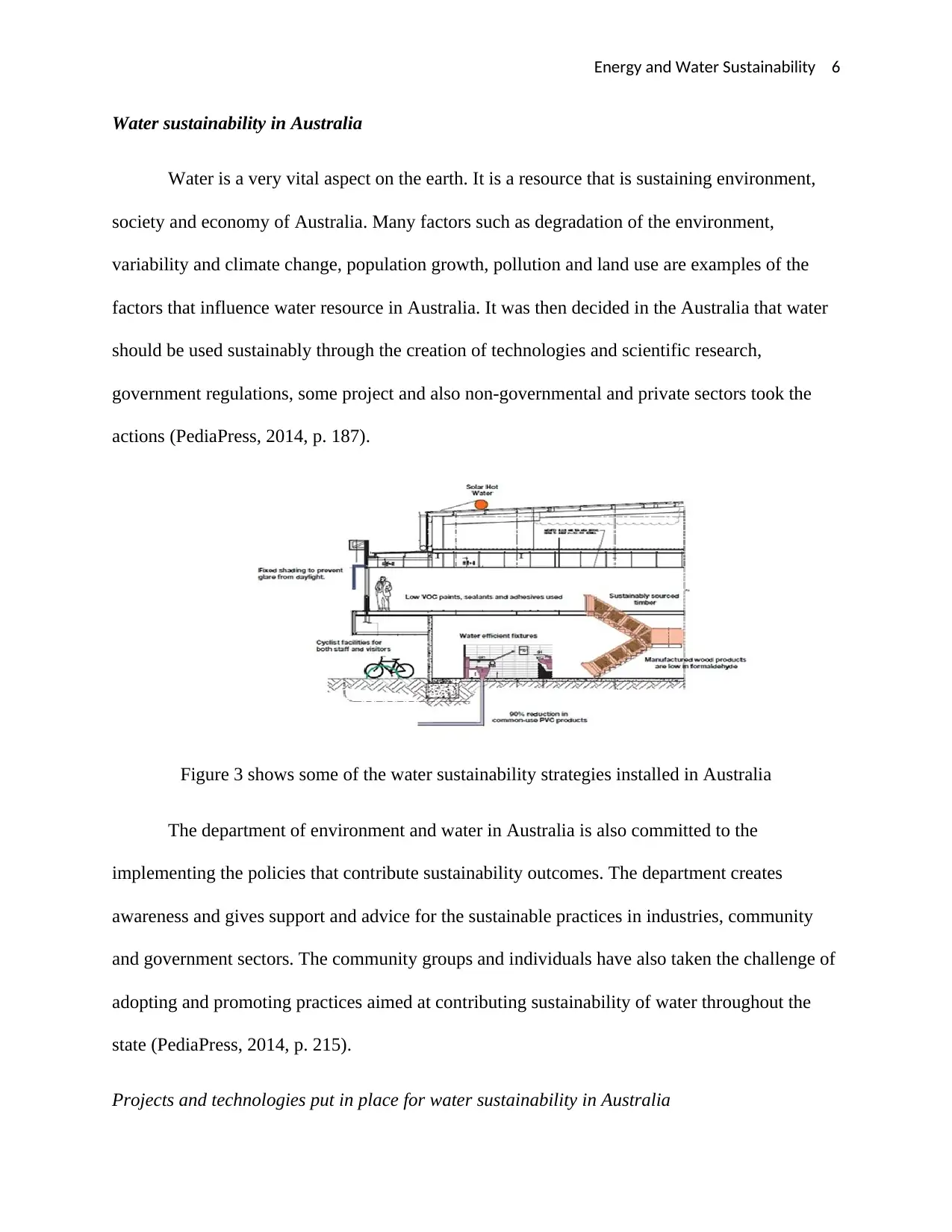
Energy and Water Sustainability 6
Water sustainability in Australia
Water is a very vital aspect on the earth. It is a resource that is sustaining environment,
society and economy of Australia. Many factors such as degradation of the environment,
variability and climate change, population growth, pollution and land use are examples of the
factors that influence water resource in Australia. It was then decided in the Australia that water
should be used sustainably through the creation of technologies and scientific research,
government regulations, some project and also non-governmental and private sectors took the
actions (PediaPress, 2014, p. 187).
Figure 3 shows some of the water sustainability strategies installed in Australia
The department of environment and water in Australia is also committed to the
implementing the policies that contribute sustainability outcomes. The department creates
awareness and gives support and advice for the sustainable practices in industries, community
and government sectors. The community groups and individuals have also taken the challenge of
adopting and promoting practices aimed at contributing sustainability of water throughout the
state (PediaPress, 2014, p. 215).
Projects and technologies put in place for water sustainability in Australia
Water sustainability in Australia
Water is a very vital aspect on the earth. It is a resource that is sustaining environment,
society and economy of Australia. Many factors such as degradation of the environment,
variability and climate change, population growth, pollution and land use are examples of the
factors that influence water resource in Australia. It was then decided in the Australia that water
should be used sustainably through the creation of technologies and scientific research,
government regulations, some project and also non-governmental and private sectors took the
actions (PediaPress, 2014, p. 187).
Figure 3 shows some of the water sustainability strategies installed in Australia
The department of environment and water in Australia is also committed to the
implementing the policies that contribute sustainability outcomes. The department creates
awareness and gives support and advice for the sustainable practices in industries, community
and government sectors. The community groups and individuals have also taken the challenge of
adopting and promoting practices aimed at contributing sustainability of water throughout the
state (PediaPress, 2014, p. 215).
Projects and technologies put in place for water sustainability in Australia
⊘ This is a preview!⊘
Do you want full access?
Subscribe today to unlock all pages.

Trusted by 1+ million students worldwide
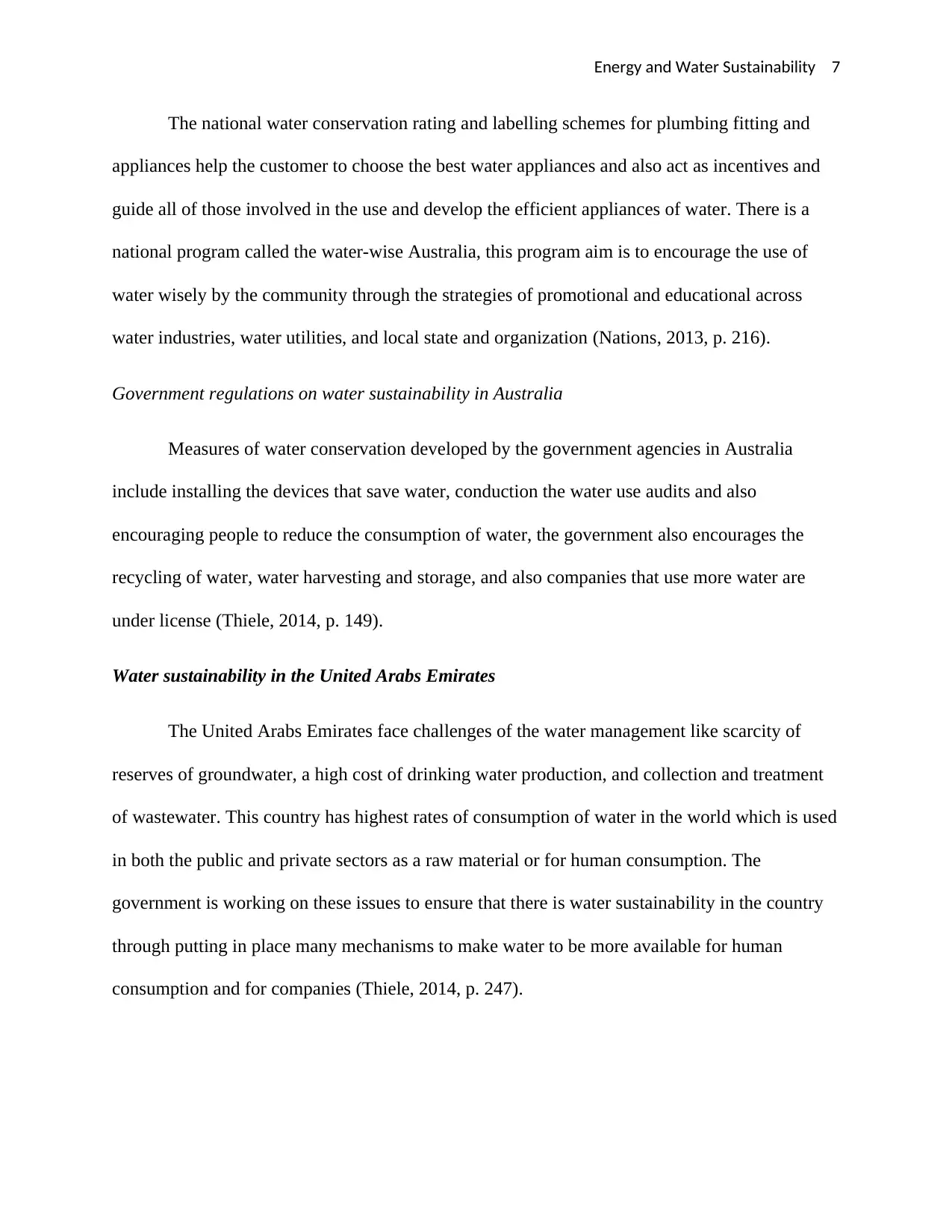
Energy and Water Sustainability 7
The national water conservation rating and labelling schemes for plumbing fitting and
appliances help the customer to choose the best water appliances and also act as incentives and
guide all of those involved in the use and develop the efficient appliances of water. There is a
national program called the water-wise Australia, this program aim is to encourage the use of
water wisely by the community through the strategies of promotional and educational across
water industries, water utilities, and local state and organization (Nations, 2013, p. 216).
Government regulations on water sustainability in Australia
Measures of water conservation developed by the government agencies in Australia
include installing the devices that save water, conduction the water use audits and also
encouraging people to reduce the consumption of water, the government also encourages the
recycling of water, water harvesting and storage, and also companies that use more water are
under license (Thiele, 2014, p. 149).
Water sustainability in the United Arabs Emirates
The United Arabs Emirates face challenges of the water management like scarcity of
reserves of groundwater, a high cost of drinking water production, and collection and treatment
of wastewater. This country has highest rates of consumption of water in the world which is used
in both the public and private sectors as a raw material or for human consumption. The
government is working on these issues to ensure that there is water sustainability in the country
through putting in place many mechanisms to make water to be more available for human
consumption and for companies (Thiele, 2014, p. 247).
The national water conservation rating and labelling schemes for plumbing fitting and
appliances help the customer to choose the best water appliances and also act as incentives and
guide all of those involved in the use and develop the efficient appliances of water. There is a
national program called the water-wise Australia, this program aim is to encourage the use of
water wisely by the community through the strategies of promotional and educational across
water industries, water utilities, and local state and organization (Nations, 2013, p. 216).
Government regulations on water sustainability in Australia
Measures of water conservation developed by the government agencies in Australia
include installing the devices that save water, conduction the water use audits and also
encouraging people to reduce the consumption of water, the government also encourages the
recycling of water, water harvesting and storage, and also companies that use more water are
under license (Thiele, 2014, p. 149).
Water sustainability in the United Arabs Emirates
The United Arabs Emirates face challenges of the water management like scarcity of
reserves of groundwater, a high cost of drinking water production, and collection and treatment
of wastewater. This country has highest rates of consumption of water in the world which is used
in both the public and private sectors as a raw material or for human consumption. The
government is working on these issues to ensure that there is water sustainability in the country
through putting in place many mechanisms to make water to be more available for human
consumption and for companies (Thiele, 2014, p. 247).
Paraphrase This Document
Need a fresh take? Get an instant paraphrase of this document with our AI Paraphraser
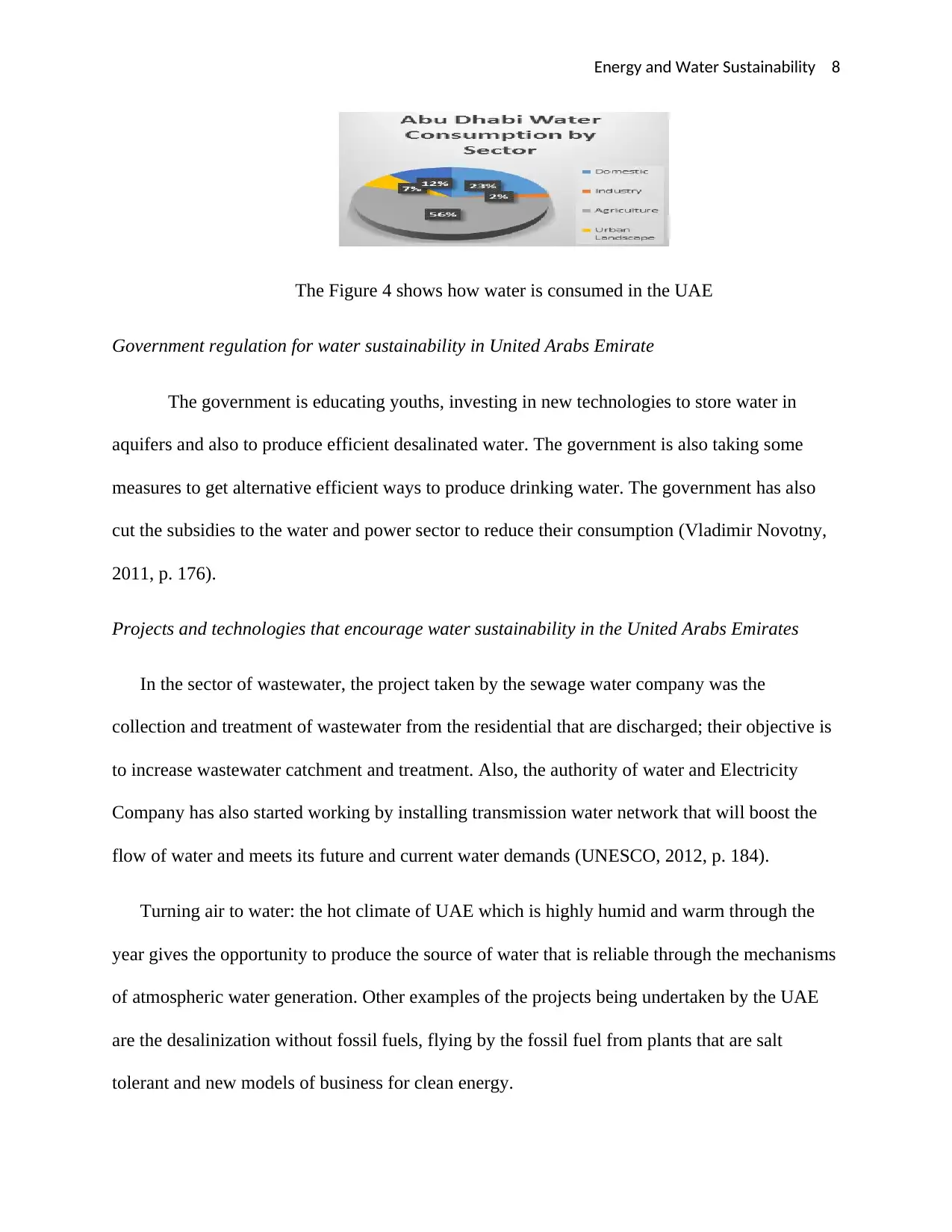
Energy and Water Sustainability 8
The Figure 4 shows how water is consumed in the UAE
Government regulation for water sustainability in United Arabs Emirate
The government is educating youths, investing in new technologies to store water in
aquifers and also to produce efficient desalinated water. The government is also taking some
measures to get alternative efficient ways to produce drinking water. The government has also
cut the subsidies to the water and power sector to reduce their consumption (Vladimir Novotny,
2011, p. 176).
Projects and technologies that encourage water sustainability in the United Arabs Emirates
In the sector of wastewater, the project taken by the sewage water company was the
collection and treatment of wastewater from the residential that are discharged; their objective is
to increase wastewater catchment and treatment. Also, the authority of water and Electricity
Company has also started working by installing transmission water network that will boost the
flow of water and meets its future and current water demands (UNESCO, 2012, p. 184).
Turning air to water: the hot climate of UAE which is highly humid and warm through the
year gives the opportunity to produce the source of water that is reliable through the mechanisms
of atmospheric water generation. Other examples of the projects being undertaken by the UAE
are the desalinization without fossil fuels, flying by the fossil fuel from plants that are salt
tolerant and new models of business for clean energy.
The Figure 4 shows how water is consumed in the UAE
Government regulation for water sustainability in United Arabs Emirate
The government is educating youths, investing in new technologies to store water in
aquifers and also to produce efficient desalinated water. The government is also taking some
measures to get alternative efficient ways to produce drinking water. The government has also
cut the subsidies to the water and power sector to reduce their consumption (Vladimir Novotny,
2011, p. 176).
Projects and technologies that encourage water sustainability in the United Arabs Emirates
In the sector of wastewater, the project taken by the sewage water company was the
collection and treatment of wastewater from the residential that are discharged; their objective is
to increase wastewater catchment and treatment. Also, the authority of water and Electricity
Company has also started working by installing transmission water network that will boost the
flow of water and meets its future and current water demands (UNESCO, 2012, p. 184).
Turning air to water: the hot climate of UAE which is highly humid and warm through the
year gives the opportunity to produce the source of water that is reliable through the mechanisms
of atmospheric water generation. Other examples of the projects being undertaken by the UAE
are the desalinization without fossil fuels, flying by the fossil fuel from plants that are salt
tolerant and new models of business for clean energy.
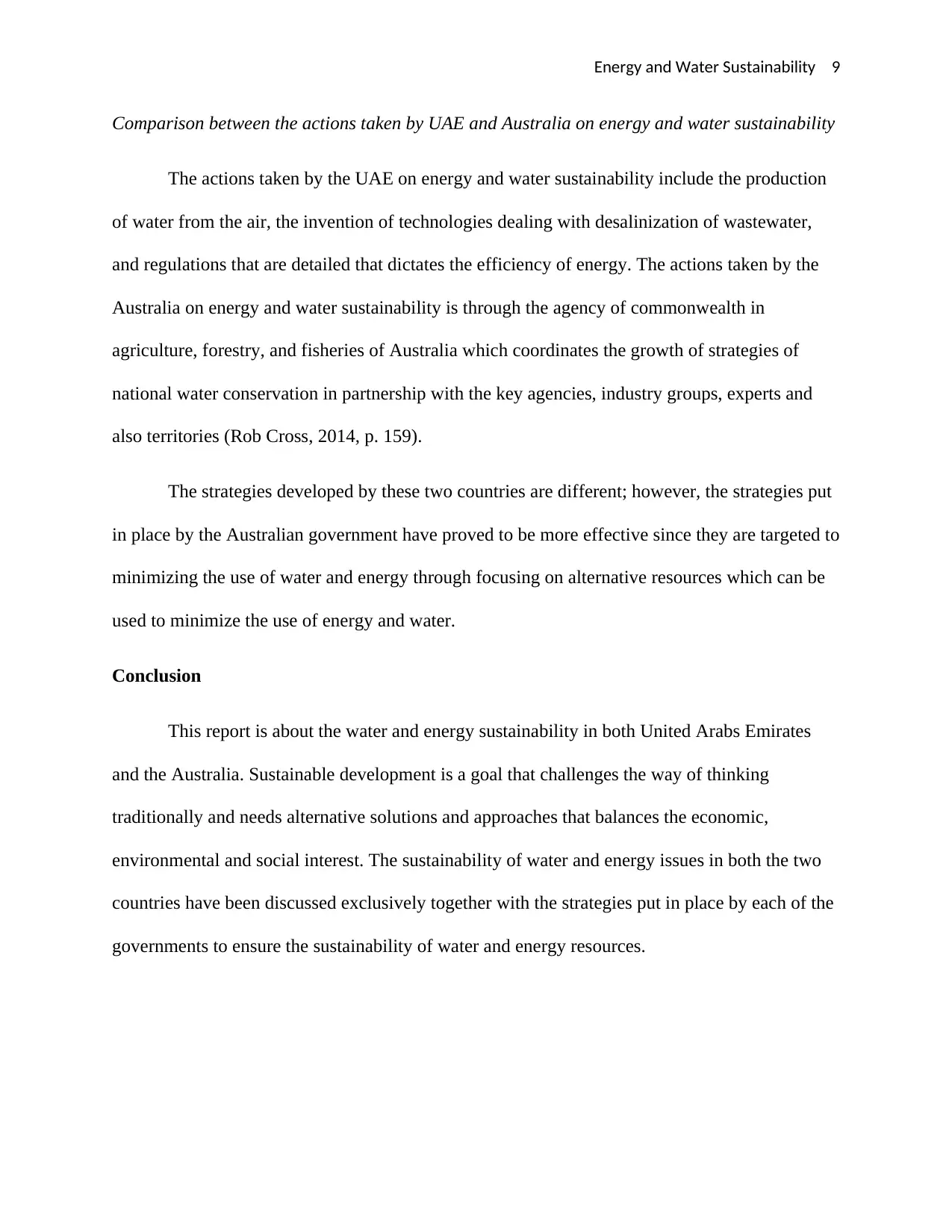
Energy and Water Sustainability 9
Comparison between the actions taken by UAE and Australia on energy and water sustainability
The actions taken by the UAE on energy and water sustainability include the production
of water from the air, the invention of technologies dealing with desalinization of wastewater,
and regulations that are detailed that dictates the efficiency of energy. The actions taken by the
Australia on energy and water sustainability is through the agency of commonwealth in
agriculture, forestry, and fisheries of Australia which coordinates the growth of strategies of
national water conservation in partnership with the key agencies, industry groups, experts and
also territories (Rob Cross, 2014, p. 159).
The strategies developed by these two countries are different; however, the strategies put
in place by the Australian government have proved to be more effective since they are targeted to
minimizing the use of water and energy through focusing on alternative resources which can be
used to minimize the use of energy and water.
Conclusion
This report is about the water and energy sustainability in both United Arabs Emirates
and the Australia. Sustainable development is a goal that challenges the way of thinking
traditionally and needs alternative solutions and approaches that balances the economic,
environmental and social interest. The sustainability of water and energy issues in both the two
countries have been discussed exclusively together with the strategies put in place by each of the
governments to ensure the sustainability of water and energy resources.
Comparison between the actions taken by UAE and Australia on energy and water sustainability
The actions taken by the UAE on energy and water sustainability include the production
of water from the air, the invention of technologies dealing with desalinization of wastewater,
and regulations that are detailed that dictates the efficiency of energy. The actions taken by the
Australia on energy and water sustainability is through the agency of commonwealth in
agriculture, forestry, and fisheries of Australia which coordinates the growth of strategies of
national water conservation in partnership with the key agencies, industry groups, experts and
also territories (Rob Cross, 2014, p. 159).
The strategies developed by these two countries are different; however, the strategies put
in place by the Australian government have proved to be more effective since they are targeted to
minimizing the use of water and energy through focusing on alternative resources which can be
used to minimize the use of energy and water.
Conclusion
This report is about the water and energy sustainability in both United Arabs Emirates
and the Australia. Sustainable development is a goal that challenges the way of thinking
traditionally and needs alternative solutions and approaches that balances the economic,
environmental and social interest. The sustainability of water and energy issues in both the two
countries have been discussed exclusively together with the strategies put in place by each of the
governments to ensure the sustainability of water and energy resources.
⊘ This is a preview!⊘
Do you want full access?
Subscribe today to unlock all pages.

Trusted by 1+ million students worldwide
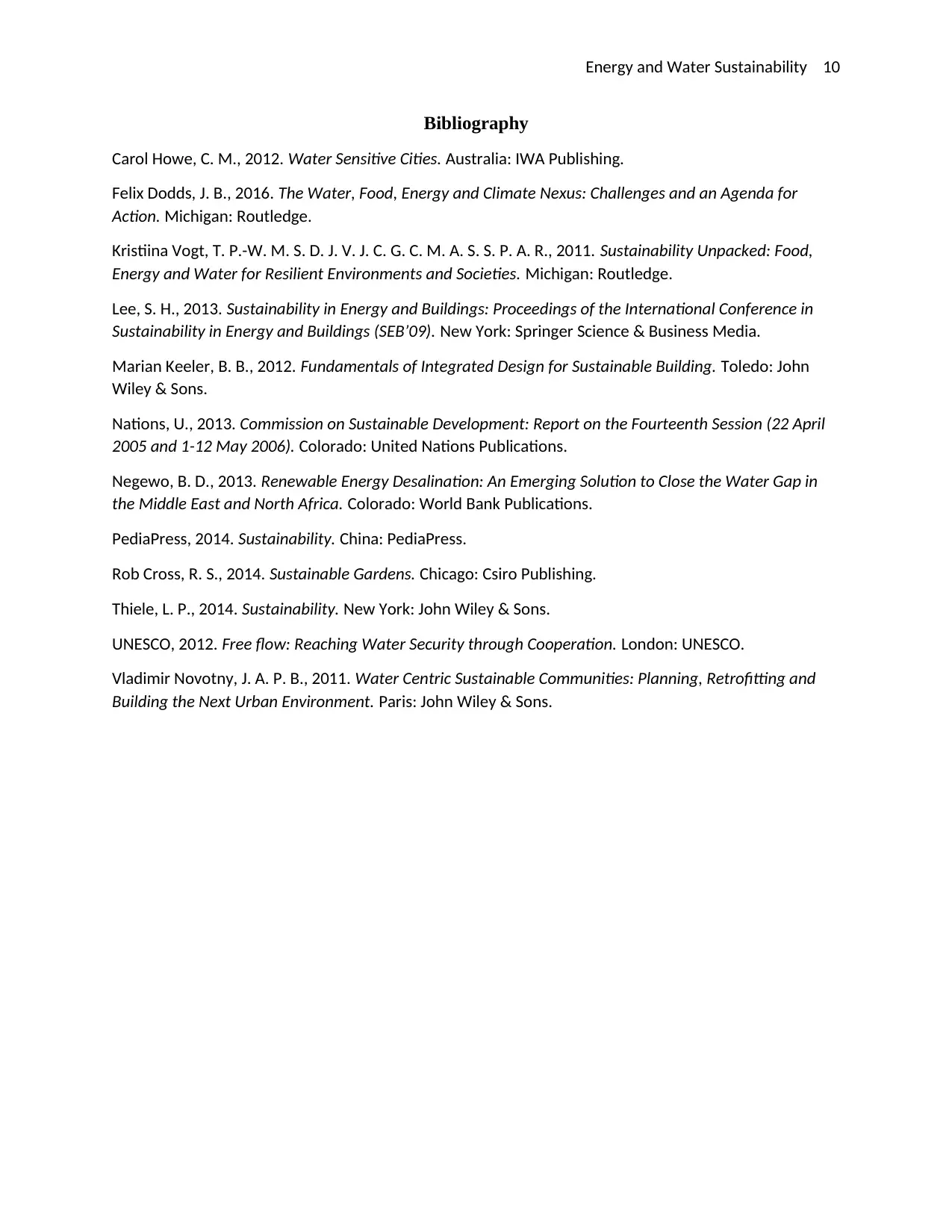
Energy and Water Sustainability 10
Bibliography
Carol Howe, C. M., 2012. Water Sensitive Cities. Australia: IWA Publishing.
Felix Dodds, J. B., 2016. The Water, Food, Energy and Climate Nexus: Challenges and an Agenda for
Action. Michigan: Routledge.
Kristiina Vogt, T. P.-W. M. S. D. J. V. J. C. G. C. M. A. S. S. P. A. R., 2011. Sustainability Unpacked: Food,
Energy and Water for Resilient Environments and Societies. Michigan: Routledge.
Lee, S. H., 2013. Sustainability in Energy and Buildings: Proceedings of the International Conference in
Sustainability in Energy and Buildings (SEB’09). New York: Springer Science & Business Media.
Marian Keeler, B. B., 2012. Fundamentals of Integrated Design for Sustainable Building. Toledo: John
Wiley & Sons.
Nations, U., 2013. Commission on Sustainable Development: Report on the Fourteenth Session (22 April
2005 and 1-12 May 2006). Colorado: United Nations Publications.
Negewo, B. D., 2013. Renewable Energy Desalination: An Emerging Solution to Close the Water Gap in
the Middle East and North Africa. Colorado: World Bank Publications.
PediaPress, 2014. Sustainability. China: PediaPress.
Rob Cross, R. S., 2014. Sustainable Gardens. Chicago: Csiro Publishing.
Thiele, L. P., 2014. Sustainability. New York: John Wiley & Sons.
UNESCO, 2012. Free flow: Reaching Water Security through Cooperation. London: UNESCO.
Vladimir Novotny, J. A. P. B., 2011. Water Centric Sustainable Communities: Planning, Retrofitting and
Building the Next Urban Environment. Paris: John Wiley & Sons.
Bibliography
Carol Howe, C. M., 2012. Water Sensitive Cities. Australia: IWA Publishing.
Felix Dodds, J. B., 2016. The Water, Food, Energy and Climate Nexus: Challenges and an Agenda for
Action. Michigan: Routledge.
Kristiina Vogt, T. P.-W. M. S. D. J. V. J. C. G. C. M. A. S. S. P. A. R., 2011. Sustainability Unpacked: Food,
Energy and Water for Resilient Environments and Societies. Michigan: Routledge.
Lee, S. H., 2013. Sustainability in Energy and Buildings: Proceedings of the International Conference in
Sustainability in Energy and Buildings (SEB’09). New York: Springer Science & Business Media.
Marian Keeler, B. B., 2012. Fundamentals of Integrated Design for Sustainable Building. Toledo: John
Wiley & Sons.
Nations, U., 2013. Commission on Sustainable Development: Report on the Fourteenth Session (22 April
2005 and 1-12 May 2006). Colorado: United Nations Publications.
Negewo, B. D., 2013. Renewable Energy Desalination: An Emerging Solution to Close the Water Gap in
the Middle East and North Africa. Colorado: World Bank Publications.
PediaPress, 2014. Sustainability. China: PediaPress.
Rob Cross, R. S., 2014. Sustainable Gardens. Chicago: Csiro Publishing.
Thiele, L. P., 2014. Sustainability. New York: John Wiley & Sons.
UNESCO, 2012. Free flow: Reaching Water Security through Cooperation. London: UNESCO.
Vladimir Novotny, J. A. P. B., 2011. Water Centric Sustainable Communities: Planning, Retrofitting and
Building the Next Urban Environment. Paris: John Wiley & Sons.
1 out of 10
Related Documents
Your All-in-One AI-Powered Toolkit for Academic Success.
+13062052269
info@desklib.com
Available 24*7 on WhatsApp / Email
![[object Object]](/_next/static/media/star-bottom.7253800d.svg)
Unlock your academic potential
Copyright © 2020–2025 A2Z Services. All Rights Reserved. Developed and managed by ZUCOL.





